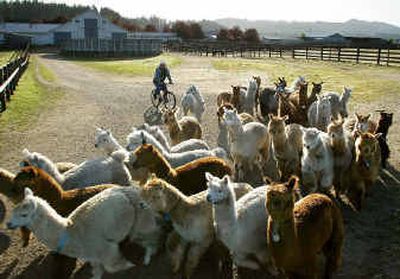Investors cash in with pet projects

TACOMA — A few of these long-necked fuzzy-faced creatures might cost as much as a four-year degree at Harvard. Most run in the range of a new car.
A nice new car, say around $30,000.
In the world of alpacas, it’s all about the money.
Yes, they’re cute. Yes, their fiber makes a fine sweater. But they aren’t built for packing cargo, and they’re not meant for food. These days, they’re an investment of increasing popularity.
Ask Randy Snow. He began a career in the exotic animal business with rare and endangered parrots. He bought his first alpaca 10 years ago. Two years later, he took over as manager of Alpacas of America, a Tenino, Wash. ranch he said is the largest alpaca operation outside of South America.
“I’d watched the market since 1984,” he said. “I watched the market for 10 years before I bought. If I could buy an animal for $12,000, I could sell the offspring for $12,000. The price caught my interest.”
Alpacas now seem to be catching the interest of other investors, as new ranches and small holdings appear around the country — especially in mild-climate areas such as Western Washington.
Hailing from the high plains of South America, the alpaca is cousin to the llama and a few uncles removed from the camel. It’s more gentle than a llama, curious and generally as sweet as a Christmas pudding.
An alpaca requires less maintenance than livestock such as cattle.
“They’re cheap to keep,” said Snow, who manages a herd of 1,600. “They’ll eat a bale of hay a month and about 11 ounces of pelleted formula a day, which works out to $30 or $40 a year. I spend more to keep my kid’s cat.”
“We came across alpacas online,” said Matt Williams of Gig Harbor, Wash. “It seemed interesting.”
Along with his partner, John Strasinger, Williams owns the 5-acre Crickhollow Farm, which now is home to 11 alpacas, plus ducks, chickens and the thought of heirloom turkeys.
“We researched all kinds of things,” Williams said. “We researched mushrooms and specialty greens, goats and goat cheese.”
They bought their first alpaca in January 2001.
“We bought a weanling, 6 months old,” Williams said. “We raised it for a year and sold it. We made a tidy profit.”
Williams had heard about investors who put their savings into the husbandry of other exotic animals and found the barn to be a house of cards.
“We looked into it,” he said. “We were concerned about that — ostriches and emus. That never really lasted. We didn’t want to invest $50,000 and have the value go down.”
Williams said the basic value of an alpaca is in the fiber.
Others say the value of an alpaca is more alpacas.
“Business is great,” Don Paton of Alger, Wash., said recently.
“We had one born yesterday and another today.”
Along with his wife, Wendy, Paton owns a ranch with a herd of about 40 alpacas. The couple is also partnered with another ranch of similar size nearby.
When he’s not ranching, Paton serves as a firefighter-paramedic with the Bellingham Fire Department.
Wendy left the department in 2000 to work the ranch.
“The first year, we didn’t make her salary back,” Paton said. “But ever since, we’ve been making as much or more as she’d been making.”
He recognizes that people are initially skeptical. Is it a sound investment?
“That’s the first question they ask,” he said.
People wonder if the same thing can happen to alpacas that happened to llamas — which once were touted as an investment but which now generally command prices below the prices of several years ago.
Paton said the primary differences concern the “national herd,” or the total number of alpacas in the United States, and the record-keeping of the bloodlines.
After an initial importation of the animals from South America — primarily Peru, Bolivian and Chile — alpacas are no longer coming ashore. The number of animals will grow, but it will grow slowly. Also, breeders keep specific DNA records of alpacas born in the United States. Animals also carry microchips for identification.
“The national herd is about 50,000 animals,” Paton said. “As the herd grows to 200,000, you’ll see the price go down.”